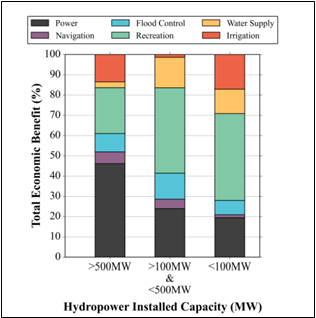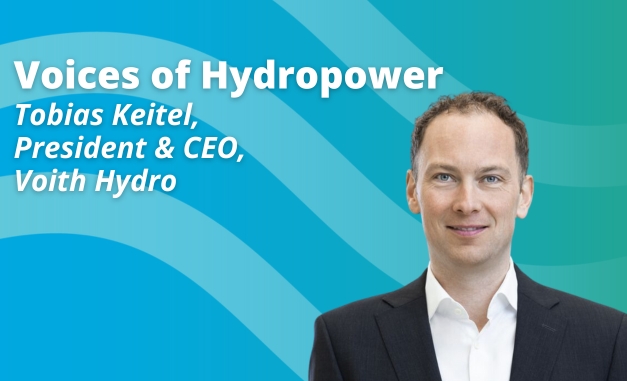Drought Management: The Functions of Hydropower
Droughts pose significant challenges to water resource management and societal well-being. This piece explores the role of the hydropower industry in drought management and mitigation.
Analysing existing literature, case studies and a proposed methodology for assessing the socio-economic value of drought management functions of hydropower infrastructure, the potential benefits and challenges associated with their implementation are highlighted.
Although recent projections show increased risks in the sector as the world gets warmer, hydropower infrastructure, while exposed to drought impacts, holds the capacity for drought risk mitigation; ensuring basin resilience and socio-economic benefits during dry conditions.
The future impacts of droughts
One study estimated the global exposure to different extents of drought over the next 50 years. The findings show that up to 5% of the global GDP will be exposed to severe and extreme droughts in the next 30 years, from up to 4.7 billion USD in the 2030s to 10 billion USD (in 2005 prices) in the 2050s. (See Figure 1 below).

Figure 1 - Global GDP exposure to droughts for the historical period and the 2030s and 2050s under different climate scenarios. Taken from Sun et al. (2022)
Another study intimates that up to 25-35% of the global GDP, as well as 1.5 billion people, are already affected by these extremes. This study suggests that up to an additional 20 trillion USD (in 2015 prices) and 1.7 billion people will become affected by droughts and heat waves by the end of the century, as demonstrated in Figure 2 below.

Figure 2 - Global exposure to compound drought and heatwave impacts. Taken from Yin et al. (2023)
The role of hydropower
In existing literature, there are many references to the multifaceted role of the hydropower industry in drought management. Multiple studies have highlighted the significance of multipurpose dams in water storage and release for mitigating water scarcity during dry periods.
These structures act as strategic reservoirs, capturing water during periods of high precipitation and releasing it during droughts to sustain water supply for various sectors – including agriculture, industry and domestic use.
Many multi-purpose dams initially built for hydropower generation also contribute to regulating river flows, which helps in balancing water availability throughout the year. By controlling the release of water, dams can mitigate the impacts of extreme low-flow periods during droughts and prevent excessive flooding during periods of heavy rainfall.
Hydropower infrastructure is estimated to store 2225 - 2430 km3 of water globally – up to 30% of the world’s artificial storage.
The storage function of hydropower reservoirs has a multiplier effect on water-intensive economic activities, such as household water provision, irrigation and other agricultural purposes. In addition, there are recreational benefits generated by the reservoir. In some cases, these seemingly secondary uses of a hydropower plant generate more economic value than the power plant itself, as illustrated in Figure 3 below.

Figure 3 - Economic benefit of hydropower plants by installed capacity. Taken from Bonnet et al. (2015)
Dams associated with the hydropower industry also provide a unique advantage in drought management through their energy generation capabilities. Hydropower plants, often integrated with dams, can produce electricity by harnessing the power of flowing water. During droughts, when other energy sources may be limited, hydropower can provide a reliable and renewable source of electricity, contributing to the stability of the energy supply.
Sustainable implementation
Social equity and community participation are key considerations highlighted in the literature. Drought management strategies should ensure that the benefits and costs of hydropower projects are distributed equitably among different societal groups. Engaging local communities, indigenous populations and other stakeholders in the decision-making processes is critical. This helps to foster inclusivity, promote sustainable development and minimise conflicts arising from water allocation and dam-related activities.
Alteration of river ecosystems, including changes in flow patterns, sediment transport, and fish migration routes, have been a concern associated with large-scale dam construction. These ecological changes can disrupt aquatic habitats, affect biodiversity, and impact the livelihoods of communities dependent on river ecosystems. Another consideration in the literature is the potential displacement of communities due to dam construction.
Large hydropower projects often require the inundation of large areas, leading to the relocation of communities residing in the affected regions. Such displacement can have socio-economic implications, including the loss of traditional livelihoods, cultural disruption, and challenges in resettlement and compensation. Therefore, sustainable hydropower solutions are required, with due consideration to social and environmental risk management and mitigation.
Overall, it is widely demonstrated that hydropower infrastructure has the capacity to contribute significantly to drought management and mitigation efforts. By providing water storage, regulation and hydropower generation capabilities, dams can enhance water supply resilience and support socio-economic development. However, careful planning, environmental impact assessment, stakeholder engagement and the integration of sustainable practices are essential for maximising the benefits of hydropower dams while minimising adverse consequences.
Potential
The hydropower drought management potential evaluation is based on the recognition of the multi-purpose nature of each hydropower dam and upstream reservoir, as well as the economic benefits they provide.
Several studies showed that even in extreme drought, hydropower generation can be sustained at 80% of normal values. In addition, there is a high reliability of water storage during drought, associated with water supply and irrigation.
Estimations show that as of 2021, the hydropower industry accounts for more than 43 billion USD worth of benefits from drought management services provision through irrigation, water supply and water storage annually.
By 2100, with drought impacting a greater share of the global GDP, the role of hydropower as a multi-purpose dam operator and water manager will increase considerably, with over 80-400 billion USD worth of drought management benefits.
Conclusion
The hydropower industry has a crucial role to play in drought management and mitigation. It has the capacity to provide essential functions such as water storage, regulation and energy generation. This can provide socio-economic benefits crucial for withstanding droughts, such as irrigation, navigation and municipal water supply worth up to 218.88 billion USD annually, a conservative estimation reaches 43.78 billion USD annually.
With an earlier assessment done by IHA on hydropower’s role in flood protection, the cumulative annual economic benefits of hydropower’s flood and drought control functions are estimated to account for 314.88 billion USD globally – 0.35% of the world GDP.
The hydropower industry stands as a key player in drought response, holding the key to unlocking a multitude of socio-economic benefits, while providing vital water management functions.
To fully harness this potential, strategic planning of water use and storage must take centre stage. Collaborative efforts involving multiple stakeholders and careful environmental considerations are imperative, as the complexities of drought management transcend sectoral boundaries and require a holistic approach.
Please get in contact if you would like to request the methodology used in this article.
Bibliography
Afzal, M. and Ragab, R., 2019. Drought Risk under Climate and Land Use Changes: Implication to Water Resource Availability at Catchment Scale. Water 2019, Vol. 11, Page 1790, 11 (9), 1790.
Ansar, A., Flyvbjerg, B., Budzier, A., and Lunn, D., 2014. Should we build more large dams? The actual costs of hydropower megaproject development. Energy Policy, 69, 43–56.
Di Baldassarre, G., Martinez, F., Kalantari, Z., and Viglione, A., 2017. Drought and flood in the Anthropocene: feedback mechanisms in reservoir operation. Earth System Dynamics, 8, 225–233.
Bastos, A., Fu, Z., Ciais, P., Friedlingstein, P., Sitch, S., Pongratz, J., Weber, U., Reichstein, M., Anthoni, P., Arneth, A., Haverd, V., Jain, A., Joetzjer, E., Knauer, J., Lienert, S., Loughran, T., McGuire, P.C., Obermeier, W., Padrón, R.S., Shi, H., Tian, H., Viovy, N., and Zaehle, S., 2020. Impacts of extreme summers on European ecosystems: a comparative analysis of 2003, 2010 and 2018. Philosophical Transactions of the Royal Society B, 375 (1810), 20190507.
Beillouin, D., Schauberger, B., Bastos, A., Ciais, P., and Makowski, D., 2020. Impact of extreme weather conditions on European crop production in 2018. Philosophical Transactions of the Royal Society B, 375 (1810).
Berga, L., 2016. The Role of Hydropower in Climate Change Mitigation and Adaptation: A Review. Engineering, 2 (3), 313–318.
Bonnet, M., Witt, A., Stewart, K., Hadjerioua, B., and Mobley, M., 2015. The Economic Benefits of Multipurpose Reservoirs in the United States-Federal Hydropower Fleet. Oak Ridge, TN.
Brown, P.H., Tullos, D., Tilt, B., Magee, D., and Wolf, A.T., 2009. Modeling the costs and benefits of dam construction from a multidisciplinary perspective. Journal of Environmental Management, 90 (SUPPL. 3), S303–S311.
Burke, E.R., Tront, J.M., Becker, A.N., Vale, A.L., Lyon, K.N., Rex, W.C., Errea, M.I., Varughese, M.C., and Newton, J.T., 2023. What the Future Has in Store : A New Paradigm for Water Storage (English). Washington, D.C.
Dadson, S.J., Garrick, D.E., . Penning-Roswell, E.C., Hall, J.W., Hope, R., and Hughes, J., 2020. Water science policy and management : a global challenge.
Gleick, P.H., 2014. Water, Drought, Climate Change, and Conflict in Syria. Weather, Climate, and Society, 6 (3), 331–340.
Grecksch, K., 2013. Adaptive capacity and regional water governance in north-western Germany. Water Policy, 15 (5), 794–815.
Hao, Z. and Singh, V.P., 2015. Drought characterization from a multivariate perspective: A review. Journal of Hydrology, 527, 668–678.
Hundertmark, W., 2008. Building drought management capacity in the Mekong River basin. Irrigation and Drainage, 57 (3), 279–287.
Hurlbert, M. and Gupta, J., 2017. The adaptive capacity of institutions in Canada, Argentina, and Chile to droughts and floods. Regional Environmental Change, 17 (3), 865–877.
Jenkins, K., Dobson, B., Decker, C., and Hall, J.W., 2021. An Integrated Framework for Risk-Based Analysis of Economic Impacts of Drought and Water Scarcity in England and Wales. Water Resources Research, 57 (8).
K. Van Aalst, M., 2006. The impacts of climate change on the risk of natural disasters. Disasters, 30 (1), 5–18.
Keovilignavong, O., Nguyen, T.H., and Hirsch, P., 2021. Reviewing the causes of Mekong drought before and during 2019–20. International Journal of Water Resources Development, 39 (1), 155–175.
Lehner, B., Liermann, C.R., Revenga, C., Vörömsmarty, C., Fekete, B., Crouzet, P., Döll, P., Endejan, M., Frenken, K., Magome, J., Nilsson, C., Robertson, J.C., Rödel, R., Sindorf, N., and Wisser, D., 2011. High-resolution mapping of the world’s reservoirs and dams for sustainable river-flow management. Frontiers in Ecology and the Environment, 9 (9), 494–502.
Marengo, J.A., Galdos, M. V, Challinor, A., Paula Cunha, A., Marin, F.R., dos Santos Vianna, M., S Alvala, R.C., Alves, L.M., Moraes, O.L., Bender, F., and Jose Marengo, C.A., 2022. Drought in Northeast Brazil: A review of agricultural and policy adaptation options for food security. Climate Resilience and Sustainability, 1 (1), e17.
McCartney, M.P. and Smakhtin, V.U., 2010. Water storage in an era of climate change: addressing the challenge of increasing rainfall variability. Blue paper.
Moran, E.F., Lopez, M.C., Moore, N., Müller, N., and Hyndman, D.W., 2018. Sustainable hydropower in the 21st century. Proceedings of the National Academy of Sciences of the United States of America, 115 (47), 11891–11898.
OECD, 2017. Multi-Purpose Water Infrastructure.
Paltán, H.A., Pant, R., Plummer Braeckman, J., and Dadson, S.J., 2021. Increased water risks to global hydropower in 1.5 °C and 2.0 °C Warmer Worlds. Journal of Hydrology, 599, 126503.
Peltonen-Sainio, P., Juvonen, J., Korhonen, N., Parkkila, P., Sorvali, J., and Gregow, H., 2021. Climate change, precipitation shifts and early summer drought: An irrigation tipping point for Finnish farmers? Climate Risk Management, 33, 100334.
Peltonen-Sainio, P., Sorvali, J., and Kaseva, J., 2021. Finnish farmers’ views towards fluctuating and changing precipitation patterns pave the way for the future. Agricultural Water Management, 255, 107011.
Ramos, M.H., Castelletti, A., Pulido-Velazquez, M., and Gustafsson, D., 2016. Weather and climate services for hydropower management. Hydropower and Environmental Sustainability.
Sadoff, C.W., Borgomeo, E., and De Waal, D., 2017. Pursuing Water Security in Fragile Contexts. Washington DC.
Siciliano, G., Urban, F., Tan-Mullins, M., and Mohan, G., 2018. Large dams, energy justice and the divergence between international, national and local developmental needs and priorities in the global South. Energy Research & Social Science, 41, 199–209.
Spalding-Fecher, R., Chapman, A., Yamba, F., Walimwipi, H., Kling, H., Tembo, B., Nyambe, I., and Cuamba, B., 2016. The vulnerability of hydropower production in the Zambezi River Basin to the impacts of climate change and irrigation development. Mitigation and Adaptation Strategies for Global Change, 21 (5), 721–742.
Sun, F., Wang, T., and Wang, H., 2022. Mapping Global GDP Exposure to Drought, 123–130.
Taraky, Y.M., McBean, E., Liu, Y., Daggupati, P., Shrestha, N.K., Jiang, A., and Gharabaghi, B., 2021. The Role of Large Dams in a Transboundary Drought Management Co-Operation Framework—Case Study of the Kabul River Basin. Water 2021, Vol. 13, Page 2628, 13 (19), 2628.
Turner, S.W.D., Voisin, N., Nelson, K., and Tidwell, V., 2022. Drought Impacts on Hydroelectric Power Generation in the Western United States A multiregional analysis of 21st century hydropower generation. Richland, Washington.
Ward, P.J., De Ruiter, M.C., Mård, J., Schröter, K., Loon, A. Van, Veldkamp, T., Von Uexkull, N., Wanders, N., Aghakouchak, A., Arnbjerg-Nielsen, K., Capewell, L., Llasat, M.C., Day, R., Dewals, B., Di Baldassarre, G., Huning, L.S., Kreibich, H., Mazzoleni, M., Savelli, E., Teutschbein, C., Van Den Berg, H., Van Der Heijden, A., Vincken, J.M.R., Waterloo, M.J., and Wens, M., 2020. The need to integrate flood and drought disaster risk reduction strategies. Water Security, 11, 100070.
Webber, H., Ewert, F., Olesen, J.E., Müller, C., Fronzek, S., Ruane, A.C., Bourgault, M., Martre, P., Ababaei, B., Bindi, M., Ferrise, R., Finger, R., Fodor, N., Gabaldón-Leal, C., Gaiser, T., Jabloun, M., Kersebaum, K.C., Lizaso, J.I., Lorite, I.J., Manceau, L., Moriondo, M., Nendel, C., Rodríguez, A., Ruiz-Ramos, M., Semenov, M.A., Siebert, S., Stella, T., Stratonovitch, P., Trombi, G., and Wallach, D., 2018. Diverging importance of drought stress for maize and winter wheat in Europe. Nature Communications 2018 9:1, 9 (1), 1–10.
World Meteorological Organization and Global Water Partnership, 2014. National Drought Management Policy Guidelines: A Template for Action Integrated Drought Management Programme.
Yin, J., Gentine, P., Slater, L., Gu, L., Pokhrel, Y., Hanasaki, N., Guo, S., Xiong, L., and Schlenker, W., 2023. Future socio-ecosystem productivity threatened by compound drought–heatwave events. Nature Sustainability 2023 6:3, 6 (3), 259–272.
Zhang, L., Song, W., and Song, W., 2020. Assessment of Agricultural Drought Risk in the Lancang-Mekong Region, South East Asia. International Journal of Environmental Research and Public Health, 17 (17), 1–24.










